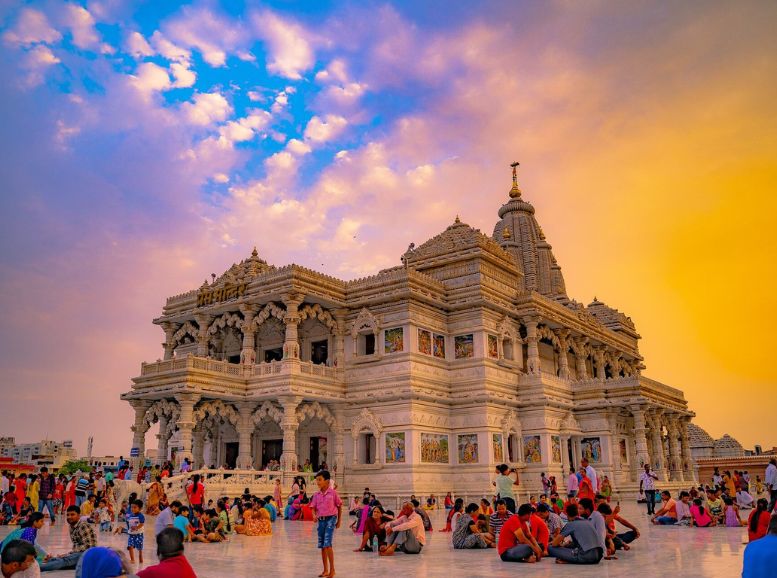Vrindavan, the mystical land where Radha and Krishna’s divine love permeates the very air. Nestled in Mathura, Uttar Pradesh, India, Vrindavan seamlessly blends mythology with reality. Every street thrums with echoes of Krishna’s enchanting flute, transporting you to a world steeped in ethereal beauty.
Vrindavan transcends a typical town; it’s a spiritual awakening. Ancient temples, bustling streets, and a vibrant culture create a haven for pilgrims and those seeking enlightenment. Join us on a captivating exploration through Vrindavan’s lanes. Let’s unveil the timeless charm and sacred aura of this town, where every moment pulsates with the essence of Radha and Krishna’s eternal love story.
How to reach:
By Air: The nearest airport to Vrindavan is the Indira Gandhi International Airport in New Delhi, which is approximately 150 kilometers away. From the airport, you can hire a taxi or take a bus to reach Vrindavan. The journey takes around 3 to 4 hours, depending on the traffic conditions.
By Train: The nearest railway station to Vrindavan is the Mathura Junction, which is well-connected to major cities like Delhi, Mumbai, Kolkata, and Chennai. From Mathura Junction, you can take a taxi, auto-rickshaw, or a local bus to reach Vrindavan, which is just 15 kilometers away. The journey takes around 30 to 45 minutes.
By Road: Vrindavan is well-connected by road to major cities in Uttar Pradesh and other neighboring states. State-owned and private buses ply regularly between Vrindavan and cities like Delhi, Agra, Jaipur, and Lucknow. You can also hire a taxi or drive your own vehicle to reach Vrindavan. The town is easily accessible via national highways and well-maintained roads.
Local Transport: Within Vrindavan, auto-rickshaws, cycle-rickshaws, and taxis are the primary modes of transport. You can easily find these vehicles for local sightseeing and commuting within the town. Many of the local attractions are within walking distance from each other, allowing you to explore Vrindavan at your own pace.
Best time to visit:
Pleasant Winters (October to March): Vrindavan thrives under winter’s gentle embrace. Temperatures range between a refreshing 10°C and a comfortable 25°C, making it ideal for sightseeing and outdoor exploration. This season also coincides with vibrant festivals like Diwali, Holi, and Janmashtami, adding to the festive spirit that permeates the town.
Hot Summers (April to June): Vrindavan experiences scorching summers, with temperatures often exceeding 40°C. While not the most comfortable time to visit, if you do choose this period, pack light cotton clothing, sunscreen, and stay hydrated throughout your stay.
Monsoonal Greenery (July to September): Vrindavan receives moderate to heavy rainfall during the monsoon season. While the rain offers a respite from the summer heat, it can also lead to waterlogging and travel inconveniences. However, if you don’t mind the rain, you’ll be rewarded with a lush green Vrindavan, brimming with natural beauty.
Attractions:
Shri Krishna Balaram Mandir (ISKCON Temple):
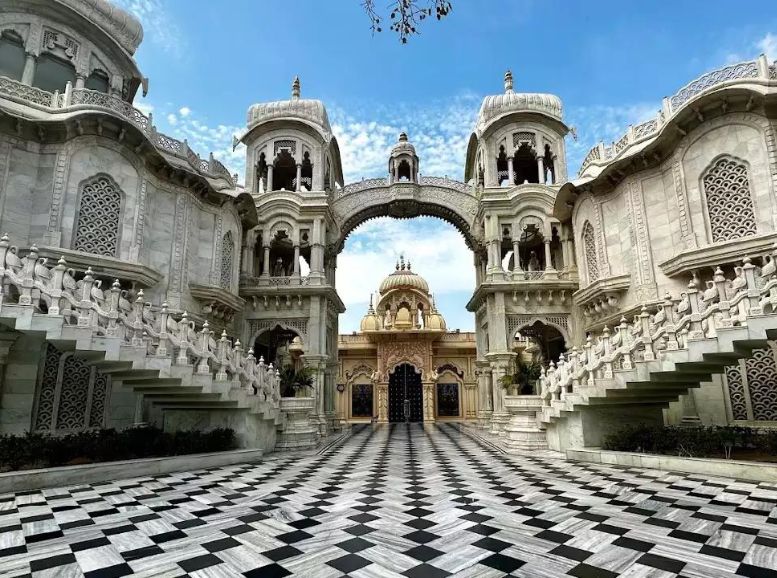
Standing tall as a monument to devotion, the ISKCON Temple, also known as the Krishna Balaram Mandir, is a captivating complex dedicated to Lord Krishna and his brother Balaram. Built by the International Society for Krishna Consciousness (ISKCON), the temple boasts magnificent architecture and exquisitely landscaped gardens. Daily aarti and kirtan sessions fill the air with soul-stirring melodies, creating an atmosphere of spiritual serenity. Enshrined within the central altar are the beautifully crafted deities of Radha Krishna, embodying the essence of divine love and eternal devotion.
Prem Mandir: Vrindavan
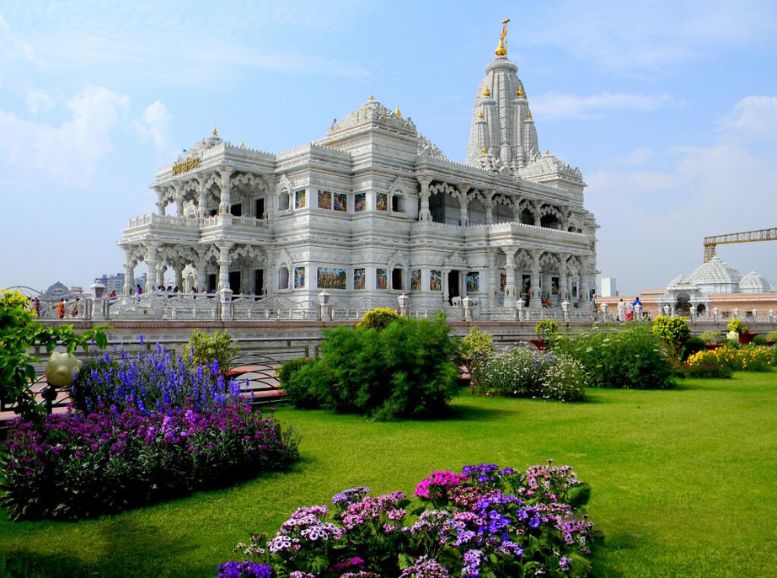
Prem Mandir, aptly named the “Temple of Divine Love,” embodies the essence of Radha-Krishna’s eternal bond. This architectural wonder, built entirely from white marble, showcases intricate carvings that dance across its surface, narrating tales of the divine couple’s legendary love story. As twilight paints the sky, Prem Mandir transforms into a breathtaking spectacle. The temple is bathed in a kaleidoscope of colored lights, illuminating its magnificent facade and transforming it into a beacon of love and devotion. Stepping inside reveals an equally captivating interior, where exquisite details adorn the sanctum, creating a truly immersive experience for devotees seeking blessings or simply wishing to marvel at the artistic mastery within.
Radha Raman Temple:
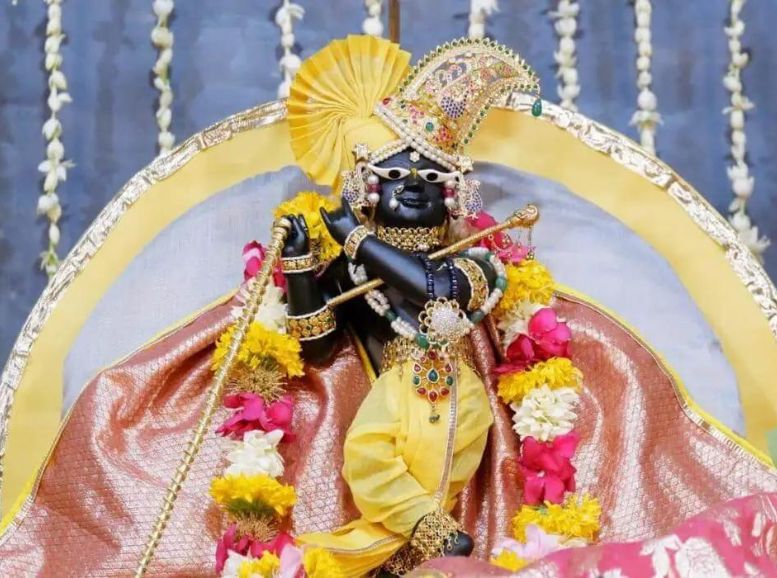
A revered pilgrimage site, the Radha Raman Temple pulsates with the energy of devoted worship. Here, Lord Krishna reigns supreme, enshrined in the captivating form of Radha Raman. Legend whispers that this sacred deity miraculously manifested from a shaligram stone, imbuing the temple with an aura of wonder. Strict daily rituals govern the temple’s practices, attracting thousands of devotees who seek blessings from Radha Raman. The serene atmosphere and intricate architecture create a powerful spiritual sanctuary, leaving a lasting impression on all who visit.
Radha Damodar Temple:
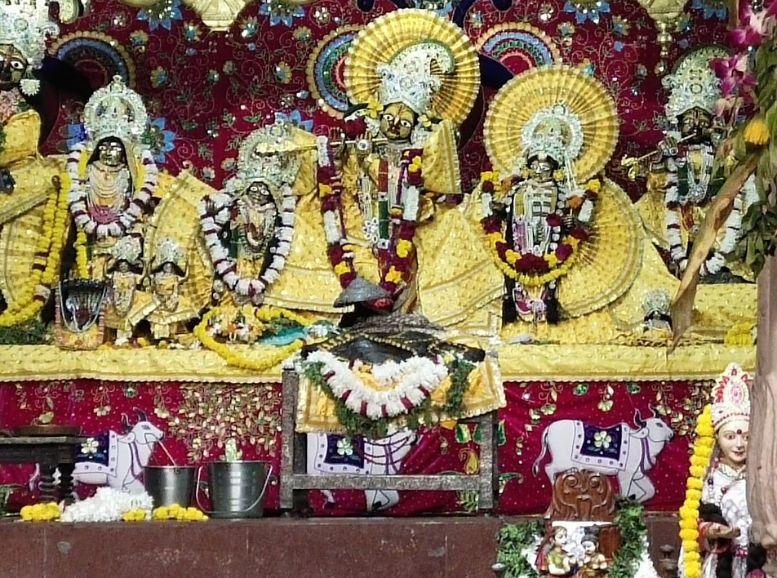
A tapestry woven with history and reverence, the Radha Damodar Temple stands as a testament to a spiritual lineage. Founded by Jiva Goswami to honor his revered guru, Shri Chaitanya Mahaprabhu, it houses a treasure beyond compare: the original deity of Shri Krishna, gifted to Rupa Goswami by Lord Chaitanya himself. This venerated shrine ranks among Vrindavan’s most esteemed pilgrimage sites. Devotees from all walks of life converge here, seeking not just spiritual enlightenment and divine blessings, but also a connection to the legacy of these revered figures. The temple pulsates with a palpable energy, a testament to the unwavering faith of countless pilgrims who have sought solace and connection with the divine within its walls.
Radha Vallabh Temple:
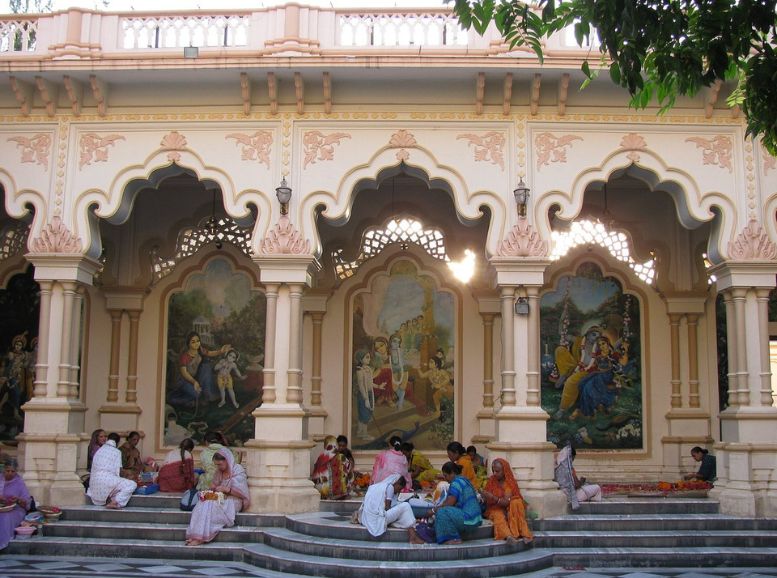
Vrindavan’s rich past finds expression in the Radha Vallabh Temple, one of the city’s most ancient sanctuaries dedicated to Radha and Krishna. This architectural gem captivates visitors with its unique blend of Mughal and Hindu styles, a testament to the region’s vibrant cultural heritage. More than just a visual spectacle, the temple is a place of deep spiritual significance, drawing devotees seeking blessings and architecture enthusiasts seeking artistic mastery. Step inside and be transported to a serene world. Intricate carvings and exquisite artwork adorn the temple walls, whispering stories of a bygone era and leaving a lasting impression of this enduringly beautiful sacred space.
Seva Kunj and Nidhuban:
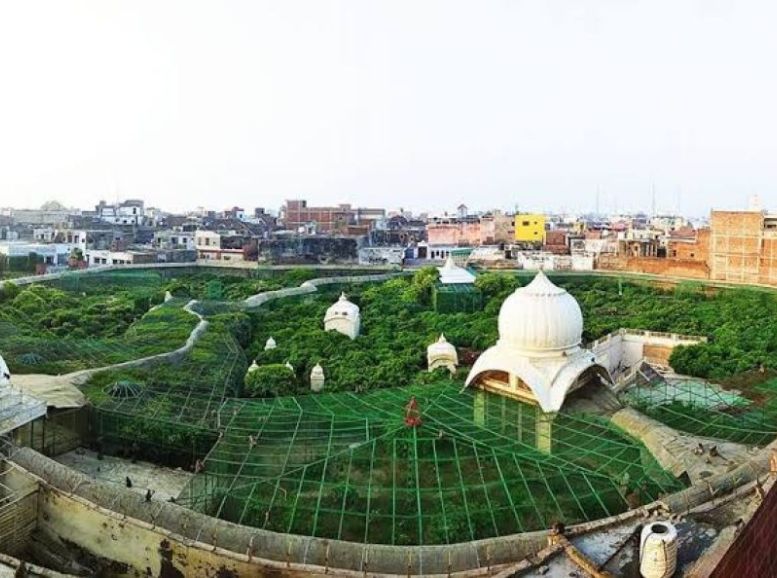
Seva Kunj and Nidhuban, bathed in an ethereal serenity, are revered as the hallowed groves where Lord Krishna is believed to have enacted the divine Raas Leela with Radha and the Gopis. Lush gardens unfurl like emerald carpets, while ancient trees stand as silent sentinels, their branches rustling with whispers of this timeless love story. Drawn by the mystical energy that permeates this sacred ground, devotees flock here to meditate and seek blessings from Radha and Krishna. The tranquility of the groves offers a refuge for spiritual seekers, allowing them to connect with the divine love that continues to resonate within these hallowed grounds. Whether seeking solace or simply captivated by the legendary romance, Seva Kunj and Nidhuban offer a truly immersive experience.
Govinda Dev Temple:
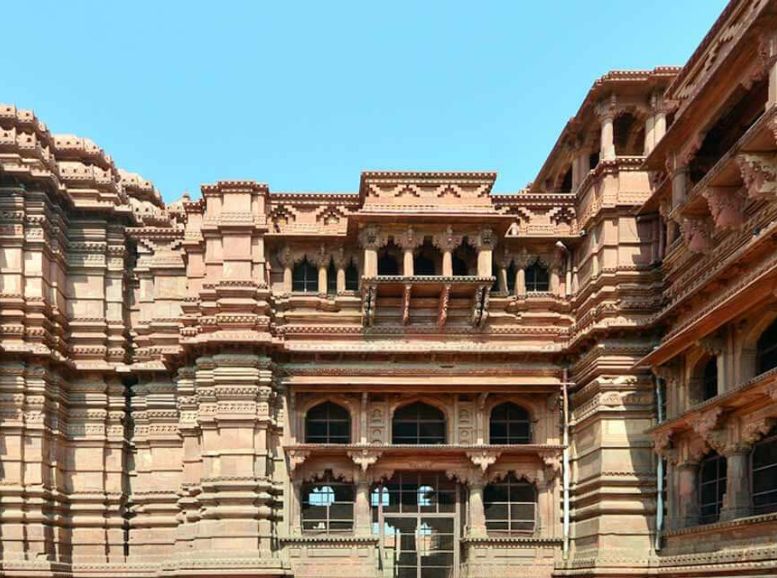
Perched atop a verdant hillock, the Govinda Dev Temple reigns supreme, a beacon of devotion to Lord Krishna. Its architectural artistry stuns visitors with intricate marble work adorning its facade, a testament to the dedication of its creators. But Govinda Dev Temple offers more than just visual grandeur. Panoramic vistas of Vrindavan unfold from the temple grounds, allowing visitors to capture the town’s spiritual essence in a single breathtaking view. Completing the experience is a serene garden nestled within the temple complex. Here, you can find a tranquil haven to relax, reflect, and fully immerse yourself in the peaceful aura that permeates this sacred space.
Madan Mohan Temple:
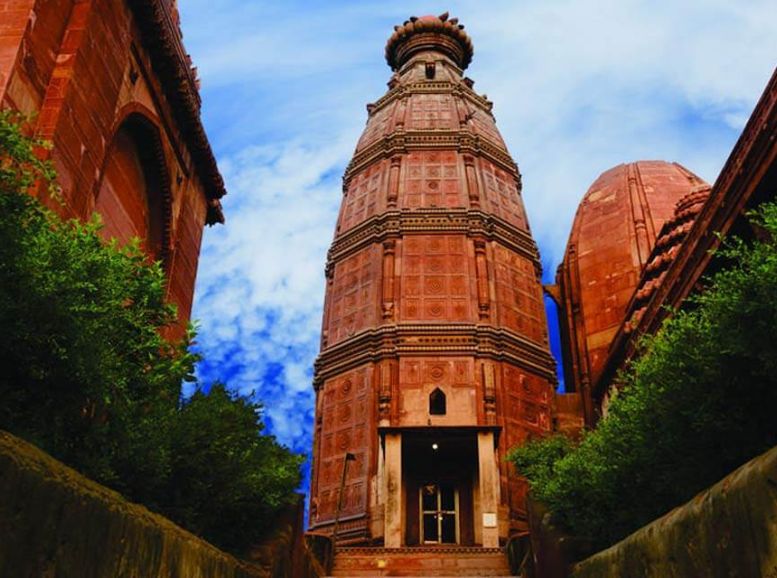
Time seems to stand still at the Madan Mohan Temple, one of Vrindavan’s most ancient sanctuaries dedicated to Lord Krishna. This revered site transcends its role as a place of worship, becoming a living testament to Vrindavan’s rich past. Intricate carvings and sculptures embellish its walls and pillars, each detail acting as a window into bygone eras. Stepping inside, visitors encounter a timeless beauty, an atmosphere that pulsates with the enduring spirit of devotion that has resonated within these walls for centuries.
Rangaji Temple:
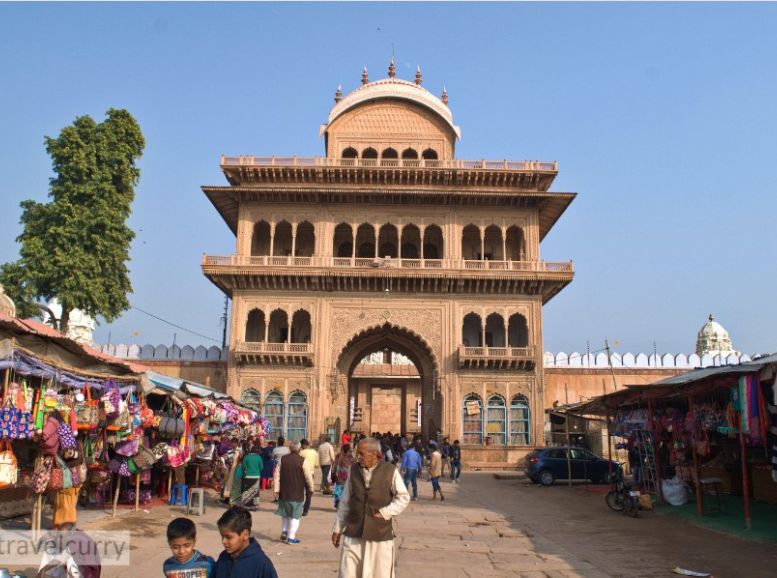
Standing tall amidst Vrindavan’s architectural tapestry, the Rangaji Temple offers a unique sensory experience. Dedicated to Lord Ranganatha, a form of Lord Vishnu, the temple’s captivating Dravidian style evokes the rich heritage of South India. Soaring towers and intricate carvings create a visually stunning spectacle. Step inside and be enveloped by the temple’s calming atmosphere. The gentle murmur of prayers blends with the soft tinkling of bells, creating a symphony of serenity. A large, serene tank reflects the temple’s grandeur, while a beautifully maintained garden offers a fragrant haven for quiet contemplation. Whether seeking spiritual solace or simply appreciating architectural artistry, Rangaji Temple provides a truly unforgettable experience.
Radha Gokulananda Temple:
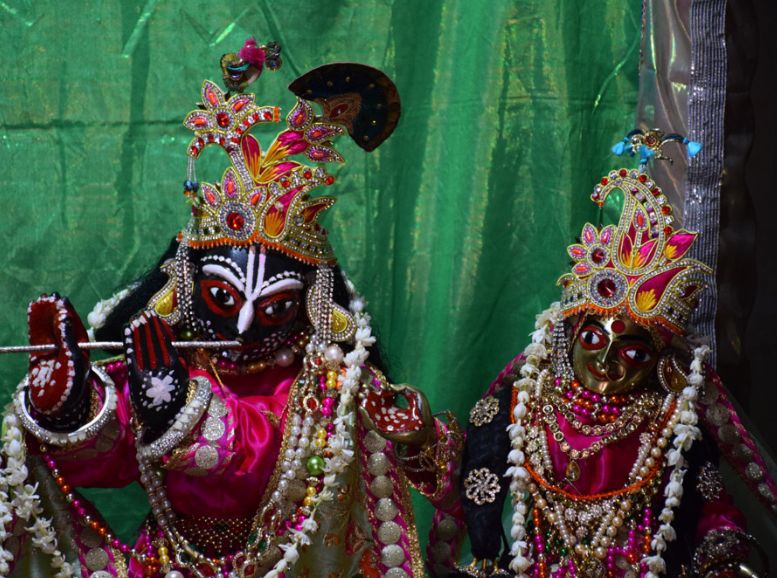
Nestled within Vrindavan’s vibrant pulse, the Radha Gokulananda Temple offers a sanctuary of serenity. Dedicated to the divine love of Radha and Krishna, this temple acts as a tranquil heartbeat amidst the bustling energy of the town. Exquisitely crafted deities of Radha and Krishna reside within, their captivating beauty drawing devotees seeking blessings from the divine couple. The temple’s peaceful ambiance fosters a deep connection, allowing visitors to lose themselves in prayer, meditation, and the timeless love story that permeates this sacred space.
Local Experiences:
- Witness the Glowing Aarti by the Yamuna: As dusk paints the sky, head to the ghats (riverbanks) on the sacred Yamuna. Witness the mesmerizing evening aarti, a ritual of worship. The air comes alive with the melodious chants of bhajans (devotional songs), the sweet fragrance of incense, and the gentle flickering of lamps as devotees offer their prayers.
- Embrace the Colors of Holi: Immerse yourself in the unbridled joy of Holi, the festival of colors, celebrated with vibrant enthusiasm in Vrindavan, the land of Krishna. Locals and visitors alike come together to playfully drench each other in vibrant powders, celebrating the eternal love of Radha and Krishna.
- Find Serenity on the Yamuna: Glide along the sacred Yamuna River on a tranquil boat ride. Soak in the serene beauty of the water while catching glimpses of the majestic temples and ghats that line its banks. This unique perspective offers a deeper appreciation for Vrindavan’s rich cultural heritage and scenic charm.
- Connect with the Sacred Cows: Visit a goshala (cow shelter) and experience the gentle nature of Vrindavan’s revered cows. Learn about the significance of cows in Hindu culture and participate in activities like feeding them or helping with their care.
- Explore the Bustling Markets: Delve into Vrindavan’s vibrant local culture by exploring its bustling markets. From Loi Bazaar to Radha Madhav Temple Market and Nidhivan Market, you’ll find an abundance of traditional handicrafts, religious artifacts, and unique souvenirs waiting to be discovered.
- Tantalize Your Taste Buds: Embark on a culinary adventure and relish the delicious local cuisine of Vrindavan. From melt-in-your-mouth sweets like peda and laddu to savory delights like kachori and samosa, the local food scene will tantalize your taste buds and leave you wanting more.
- Give Back to the Community: Make a positive impact during your visit by volunteering at a local charity or NGO. Whether it’s teaching at a school, participating in cleanliness drives, or assisting with healthcare or environmental initiatives, there are many ways to contribute to the well-being of Vrindavan.
- Unwind with Satsang or Kirtan: Immerse yourself in the spiritual essence of Vrindavan by attending a satsang (spiritual discourse) or kirtan (devotional singing) session. Experience the power of collective prayer and chanting as you connect with the divine and find inner peace.
Travel tips:
- Embrace the Pleasant Winters: Vrindavan’s summer heat can be intense. Opt for a visit between October and March, when balmy weather makes sightseeing and outdoor adventures a delight.
- Dress with Respect: Vrindavan’s sanctity is paramount. Opt for modest clothing when visiting temples and religious sites. Remember to remove footwear before entering.
- Be Cash-Ready: While ATMs exist, carrying cash ensures smooth transactions, especially in smaller markets where cards might not be accepted.
- Embrace Local Customs: Vrindavan’s rich culture thrives on tradition. Be respectful, seek permission for photos at religious sites, and immerse yourself in the local spirit.
- Stay Sun-Smart: Vrindavan’s sunny days can be dazzling. Stay hydrated, and pack sunscreen, a hat, and sunglasses for optimal protection.
- Plan Your Stay Early: Vrindavan is a popular pilgrimage destination, especially during festivals. Booking accommodation in advance ensures a hassle-free stay.
- Uncover Hidden Gems with a Guide: Consider hiring authorized tour guides. Their knowledge of Vrindavan’s history, culture, and religious significance can elevate your experience.
- Stay Alert: As with any tourist destination, be cautious of touts and scams. Be wary of unsolicited services or deals that seem too good to be true. Verify guide credentials and avoid sharing personal information with strangers.
- Be a Green Pilgrim: Help Vrindavan stay pristine! Dispose of waste responsibly and be mindful of the environment during your visit.
- Safety First: Vrindavan is generally safe, but basic precautions are wise. Keep your belongings secure, avoid isolated areas at night, and stay alert in crowded spaces.
Conclusion
Vrindavan transcends a typical destination, blossoming into a spiritual odyssey that awakens the soul. Here, ancient temples, sacred ghats, vibrant culture, and rich heritage weave a tapestry where mythology dances to life. Labyrinthine lanes and bustling markets pulsate with an undeniable mystical charm and spiritual energy. Whether you’re a pilgrim seeking blessings, a history enthusiast captivated by the past, or a curious traveler yearning to immerse yourself in the local spirit, Vrindavan has something waiting to be discovered. Let Xplro.com be your guide to unlocking the enchantment of Vrindavan. Explore hidden gems, captivating temples, cultural nuances, and must-try experiences. Xplro.com equips you to craft an unforgettable Vrindavan pilgrimage, where every moment resonates with the eternal love story of Radha and Krishna.
FAQs
What is the significance of Vrindavan?
- Vrindavan is a sacred town located in the Mathura district of Uttar Pradesh, India. It is revered as the land of Radha and Krishna’s eternal love and is believed to be the place where Lord Krishna spent his childhood and performed his divine pastimes.
What are the main attractions in Vrindavan?
- Some of the main attractions include the Banke Bihari Temple, Shri Krishna Balaram Mandir (ISKCON Temple), Prem Mandir, Radha Raman Temple, Seva Kunj and Nidhuban, Govinda Dev Temple, Madan Mohan Temple, and Rangaji Temple, among others.
What is the best time to visit Vrindavan?
- The best time to visit Vrindavan is during the winter months, from October to March, when the weather is pleasant and ideal for sightseeing and outdoor activities.
How can I reach Vrindavan?
- Vrindavan is well-connected by air, rail, and road. The nearest airport is the Indira Gandhi International Airport in New Delhi, and the nearest railway station is Mathura Junction. Vrindavan is also well-connected by road to major cities in Uttar Pradesh.
Is Vrindavan safe for tourists?
- Yes, Vrindavan is generally safe for tourists. However, it’s advisable to practice basic safety measures such as keeping your belongings secure and avoiding isolated areas after dark.
What should I wear when visiting temples in Vrindavan?
- Visitors to temples in Vrindavan are advised to dress modestly and conservatively, avoiding revealing clothing. It is also customary to remove your shoes before entering temple premises.
Are there any local markets in Vrindavan?
- Yes, Vrindavan is home to several bustling local markets where visitors can shop for traditional handicrafts, religious artifacts, and souvenirs. Popular markets include the Loi Bazaar, Radha Madhav Temple Market, and Nidhivan Market.
What are some local experiences I can try in Vrindavan?
- Some unique local experiences to try in Vrindavan include attending the evening aarti at the ghats, participating in Holi celebrations, taking a boat ride on the Yamuna River, exploring the local markets, tasting the local cuisine, and volunteering at a local charity or NGO.
Can I hire a tour guide in Vrindavan?
- Yes, authorized tour guides are available in Vrindavan who are knowledgeable about the town’s history, culture, and religious significance. They can provide valuable insights and enhance your overall experience.
Are there any accommodation options in Vrindavan?
- Yes, Vrindavan offers a range of accommodation options including hotels, guesthouses, and ashrams, catering to every budget. It’s advisable to book your accommodation in advance, especially during the festive season.
What are the famous festivals celebrated in Vrindavan?
- Vrindavan is famous for its vibrant festivals, including Holi, Janmashtami, Radha Ashtami, and Diwali. These festivals are celebrated with great fervor and enthusiasm, attracting devotees and tourists from all over the world.
How can I contribute to the local community in Vrindavan?
- Visitors to Vrindavan can contribute to the local community by volunteering for social causes such as teaching at local schools, participating in cleanliness drives, or working with NGOs involved in healthcare, education, and environmental conservation.




